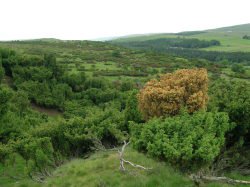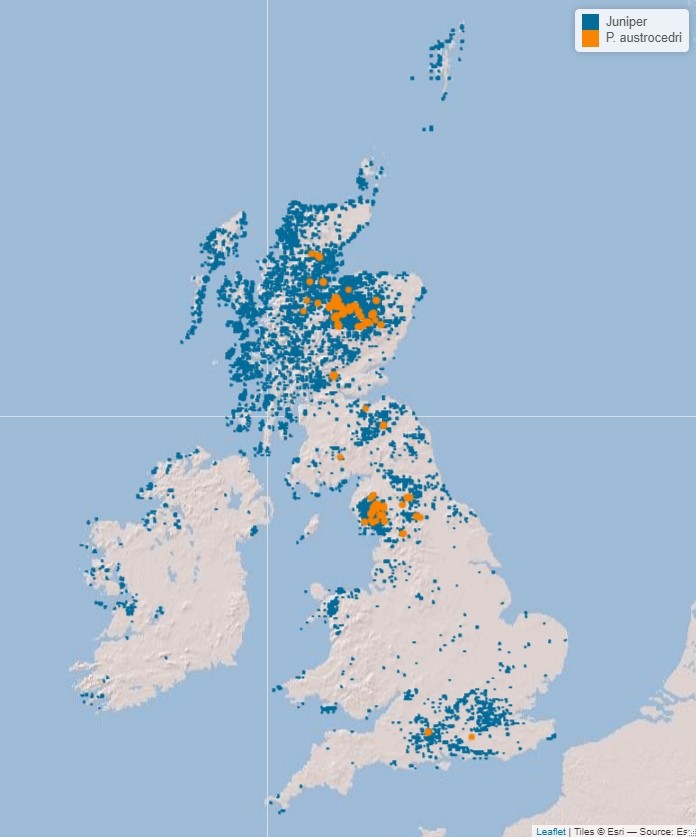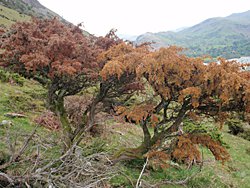Present in United Kingdom
Notifiable in trade – see ‘Report a sighting’ below
Scientific name – Phytophthora austrocedri (P. austrocedri)

Phytophthora austrocedri (P. austrocedri) is an aggressive, fungus-like pathogen which infects juniper and cypress trees (trees in the Juniperus and Cupressus genera), causing dieback and tree death.
The name was previously spelled Phytophthora austrocedrae.
P. austrocedri is known to be present in Argentina, England and Scotland. It has also been reported on a single Mediterranean cypress (Cupressus sempervirens) in a public park in Iran.
In Scotland, significant outbreaks have occurred in the Cairngorms National Park and a Site of Special Scientific Interest (SSSI) at Glen Artney, Perthshire. There are smaller outbreaks elsewhere, including southern Scotland.
In England, outbreaks have occurred in the north at the Upper Teesdale National Nature Reserve (NNR) and at various sites in the Lake District in Cumbria. A smaller number of cases have been confirmed in southern England.
There have been no confirmed cases in Wales and Northern Ireland.
The map below shows the locations of confirmed UK cases as at January 2020.

Map compiled by F. Donald (PhD candidate, UKCEH, Forest Research and University of Cambridge) from data supplied by the BSBI, Forest Research and the Forestry Commission.
All species of juniper are susceptible to P. austrocedri infection.
It has also been found infecting individual amenity specimens of Lawson cypress (Chamaecyparis lawsoniana) and Nootka Cypress (C. nootkatensis) in Scotland, and a Mediterranean cypress in Iran.
All the reported hosts (susceptible species) are members of the cypress (Cupressaceae) family.
Common juniper (Juniperus communis) is an important native species, and a significant proportion of the small area of juniper woodland remaining in Great Britain is protected. It is a key food plant for a wide range of invertebrates and birds, and it has a unique and specialised group of associated insects, fungi and lichens.
P. austrocedri is potentially serious for the juniper population at Upper Teesdale, because these are rare plants and this site has the second-largest population of the species in the UK.
Figures from Natural England indicate that, of 35 SSSIs in England where juniper is a qualifying feature, 66% are in unfavourable condition. (‘Juniper features’ document provided on 13/06/2019 to Freedom of Information request number 4662)
Scotland’s juniper faces similar difficulties in sustaining viable populations: in 2017 Scottish Natural Heritage reported that juniper in 30% of Special Areas of Conservation (SACs), and 58% in SSSIs, was in unfavourable condition.
Common juniper was already recognised as vulnerable in Great Britain before P. austrocedri was confirmed here. Since about 1990 its extent and condition have declined considerably, especially on upland sites, where its importance is tied in with nature conservation and game management. Overgrazing, burning, afforestation, lack of regeneration and other land-use changes are factors in its decline
P. austrocedri infection could accelerate this decline.

P. austrocedri most often attacks the roots and root collars, moving up into the bases of stems (trunks), and the lower parts of branches: the pathogen can extend 50 cm or more up diseased stems. Symptoms include:
To examine the phloem, cut away the outer bark from the base of the tree.
P. austrocedri symptoms can be confused with those of other root-infecting fungi, although these typically cause a crumbly wood decay in the roots and stem, which is not symptomatic of P. austrocedri infection.
Physical damage caused by heavy snow or drought might result in similar browning of the foliage, but there would be no associated lesions.
Further guidance to identifying whether a juniper is infected is available in this Pest Alert. (Please note that the contact details provided in the Pest Alert have been superseded by those given on this page.)
P. austrocedri is a notifiable pathogen in the plant trade, but not in the wider environment, and suspected cases in the trade must be reported to the plant health authorities. These are:
In addition, owners of unhealthy juniper trees can request a diagnosis from our Tree Health Diagnostic & Advisory Service. These can be requested with our on-line tree disease reporting tool, TreeAlert, or with the contact details provided on the web page. Please note that there is usually a fee for this service.
See our guidance on how to collect and package samples for testing.
P. austrocedri primarily attacks juniper roots, killing phloem cells and forming lesions which extend up into the lower stem. (Phloem cells are the inner-bark tissue which acts as the tree’s transport system for soluble nutrients).
Eventually the lesion girdles the main stem, cutting off the flow of nutrients entirely, and kills the tree.
Research has shown that the pathogen spreads in water; by movement of infected plant material; and by movements of contaminated soil such as soil sticking to footwear, walking poles, camping equipment and vehicle wheels. The fact that it can be spread by water makes it particularly difficult to control.
The best means of minimising its spread in the wider environment is to follow good biosecurity (plant hygiene) practice, such as cleaning and disinfecting footwear, tools and vehicles before entering and after leaving juniper sites. Further biosecurity guidance is available on the UK Government website.
The following materials provide more detailed advice and guidance on planting and managing juniper to prevent or minimise the occurrence and spread of P. austrocedri.
Imports of Juniperus and Chamaecyparis species from Third Countries (non-European Union countries) are banned under EU phytosanitary (plant health) legislation. Other host species are not prohibited, but they must be accompanied by a phytosanitary certificate declaring that they are free from harmful organisms.
Because P. austrocedri is notifiable when it is found in the plant trade, such as in nurseries, statutory action is taken on findings. This usually involves destruction of the infected stock.
In the wider environment, the plant health authorities work in collaboration with conservation organisations and other stakeholders to protect unaffected areas where possible. At known infected sites, they work in collaboration with conservation organisations, land managers and other stakeholders to minimise the risk of spread.
Forest Research is involved in a number of projects to study Phytophthora infections in UK trees.
Our scientists also contributed to the paper ‘Small-scale variability in soil moisture drives infection of vulnerable juniper populations by invasive forest pathogen’.
P. austrocedri was first isolated, as a then-unknown Phytophthora, on a creeping juniper (J. horizontalis) plant in an import-export nursery in Germany in the early 2000s.
It was first fully described in 2007, when it was discovered to be the cause of dieback and deaths of Chilean cedar (Austrocedrus chilensis) in Argentina, where the disease it causes is known as “Mal del Ciprés”. Chilean cedar is a South American native species of conifer tree, and the only species in the Austrocedrus genus. It is also known as Patagonian cypress and Cordilleran cypress.
The pathogen is now thought to have been present in Argentina since at least the 1960s. Genetic evidence suggests that it was introduced to South America and Great Britain from elsewhere, but exactly where is still unknown.
Forest Research had been researching for some time the dieback in juniper trees in Natural England’s Upper Teesdale National Nature Reserve (NNR), and at the Glen Artney SSSI in Perthshire. In 2011 these studies confirmed the presence of P. austrocedri.
Since then it has been found at many upland woodland sites in Scotland and northern England, and at a few sites in southern England. Where it originated from and how it entered Great Britain are not known, but it is likely that it entered through the international trade in plants for planting.